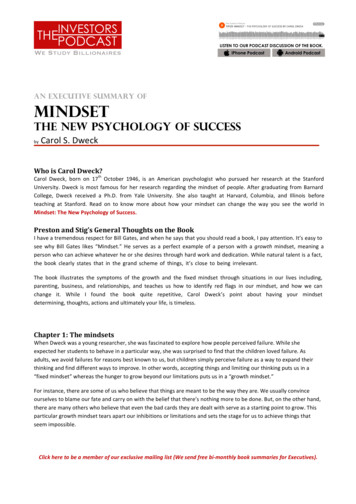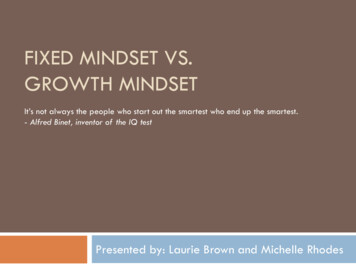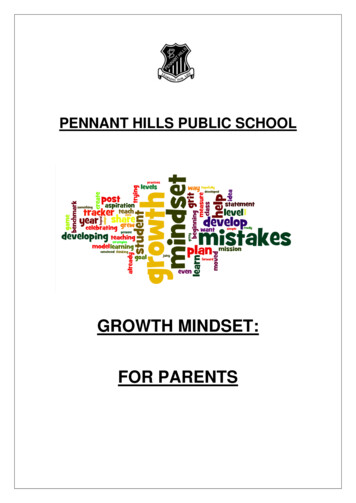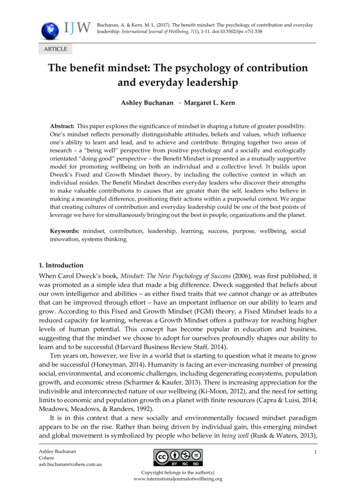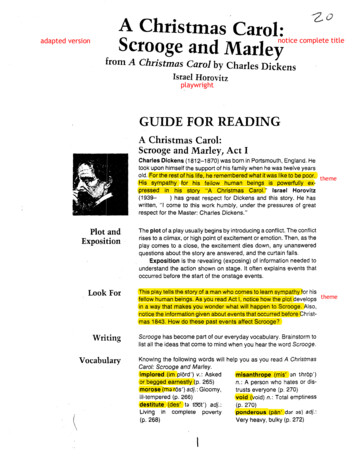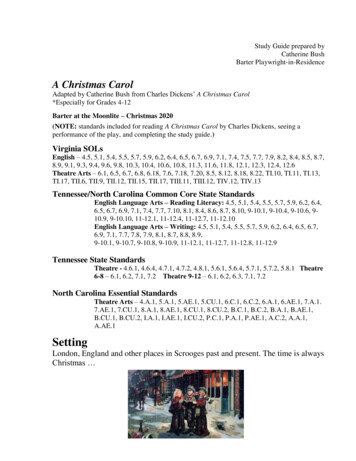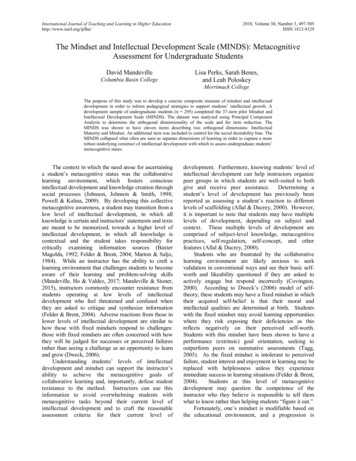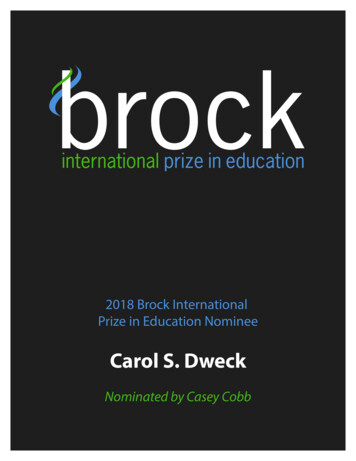
Transcription
2018 Brock InternationalPrize in Education NomineeCarol S. DweckNominated by Casey Cobb
Brock Nominee:Carol S. DweckLewis and Virginia Eaton Professor of PsychologyProfessor of Education (by Courtesy)Stanford University
Table of ContentsIntroduction to Carol Dweck . 3Her groundbreaking book, Mindset. . 4Praise for Mindset . 5SUMMARY OF CAROL DWECK’S INNOVATIVE THEORY AND APPLICATION OF A “GROWTHMINDSET” . 6CAROL DWECK’S RESEARCH . 7GROWTH-MINDSET INTERVENTIONS . 7SCALING GROWTH-MINDSET INTERVENTIONS . 8GROWTH-MINDSET PRACTICES . 9INFLUENCE. 12Quotes of Support from Respected Peers . 13Epilogue. 132
Introduction to Carol DweckCarol S. Dweck, Ph.D., is a leading researcher in the field of motivation and is the Lewis andVirginia Eaton Professor of Psychology at Stanford. Her research focuses on why studentssucceed and how to foster their success. Dr. Dweck is an expert in the area of fixed vs. growthmindset: the belief that intelligence is fixed (you either have it or you don’t) vs. the belief thatintelligence can grow with nurturing and hard work. Her research shows that people whobelieve intelligence is fixed and people faced with stereotype threat perform more poorly thanthose who believe intelligence can grow or who reject the shortcomings implied by stereotypes.Her work has demonstrated the role of mindsets in success and has shown how praise forintelligence can undermine people’s motivation and learning.Dr. Dweck has held professorships at and Columbia and Harvard Universities, has lectured toeducation, business, and sports groups all over the world, and has been elected to theAmerican Academy of Arts and Sciences and the National Academy of Sciences. She recentlywon the Distinguished Scientific Contribution award from the American PsychologicalAssociation, the highest award in Psychology.Her work has been prominently featured in such publications as The New Yorker, Newsweek,Time, The New York Times, and The London Times, with recent feature stories on her work inthe San Francisco Chronicle and the Washington Post, and she has appeared on such shows asToday, Good Morning America, NPR’s Morning Edition, and 20/20. Her bestselling bookMindset (published by Random House) has been widely acclaimed and has been translated into20 languages.Quick Hits:Ø Her Stanford University profileØ A 3-minute interview with Carol Dweck on The Growth Mindset by Sal Khan of KhanAcademyØ A 10-minute TED talk on Developing a Growth Mindset by Carol DweckØ The cover story from the Stanford Alumni Journal presents a nice overview of Carol andher work. “The Effort Effect”Ø A short news article on Carol in the UK’s SchoolsWeekØ Carol and her graduate students developed this free, online program called PERT(https://www.perts.net/), which provides platforms to deliver and evaluate mindsetinterventions online.3
Her groundbreaking book, Mindset.4
Abstract for MindsetAfter decades of research, world-renowned Stanford University psychologist Carol S. Dweck,Ph.D., discovered a simple but groundbreaking idea: the power of mindset. In this brilliantbook, she shows how success in school, work, sports, the arts, and almost every area of humanendeavor can be dramatically influenced by how we think about our talents and abilities.People with a fixed mindset—those who believe that abilities are fixed—are less likely toflourish than those with agrowth mindset—those who believe that abilities can bedeveloped. Mindset reveals how great parents, teachers, managers, and athletes can put thisidea to use to foster outstanding accomplishment.Praise for Mindset“A good book is one whose advice you believe. A great book is one whose advice you follow.This is a book that can change your life, as its ideas have changed mine.”—Robert J. Sternberg,co-author of Teaching for Wisdom, Intelligence, Creativity, and Success“An essential read for parents, teachers [and] coaches . . . as well as for those who would like toincrease their own feelings of success and fulfillment.”—Library Journal (starred review)“Everyone should read this book.”—Chip Heath and Dan Heath, authors of Made to Stick“One of the most influential books ever about motivation.”—Po Bronson, authorof NurtureShock“If you manage people or are a parent (which is a form of managing people), drop everythingand read Mindset.”—Guy Kawasaki, author of The Art of the Start 2.05
SUMMARY OF CAROL DWECK’S INNOVATIVE THEORY ANDAPPLICATION OF A “GROWTH MINDSET”Carol Dweck’s research on lay theories of intelligence is revolutionizing education. It is helpingto create better school environments and promoting learning and achievement for millions ofchildren. In both scientific publications of the highest caliber (e.g., in Science), in her bestsellingbook, “Mindset: The New Psychology of Success,” and in high-profile (e.g., TED:https://www.ted.com/talks/carol dweck the power of believing that you can improve) talks,Dr. Dweck explores a fundamental distinction. People can believe that intelligence is fixed—thatyou either have it or you do not. From this perspective, struggle and setbacks in school are a signof inability, and students respond by withdrawing effort. But people can also believe thatintelligence can grow—that with hard work, help from others, and good strategies you can getsmarter tomorrow than you are today. With this “growth mindset,” challenges and setbacks are asign that one has not mastered the material yet, and students respond by increasing their effortsor finding new ways to learn. Moreover, as Dr. Dweck and her collaborators have shown, agrowth mindset can be taught and when this is done students’ performance arises. Moreover, thegreatest benefits are often for the most struggling students—because it is for them that strugglesin school can be most threatening. They are most likely to infer after a setback that they are“dumb” or “not good at math” and then withdraw.Following early theorizing (e.g., Dweck, 1986; Dweck, & Leggett, 1988) and laboratoryexperiments (e.g., Mueller & Dweck, 1998), Dr. Dweck and colleagues developed a 6-sessionworkshop to teach a low-income, ethnic-minority group of middle school students a growthmindset (Blackwell, Trzesniewski, & Dweck, 2007). Whereas students randomized to the controlcondition showed continued decline in their math scores, those who received the growth-mindsetmessage showed a rebound in performance and higher final grades. Since this seminal study,growth-mindset interventions have caught fire. Brief online modules created by Dr. Dweck andher doctoral students that teach the growth mindset can reach tens-of-thousands of children and,when this was done, raised grades and successful course completion, especially amongstruggling students (Paunesku, Walton, Romero, Smith, Yeager, & Dweck, 2015). Such modulesare now being scaled nationally in the United States, k/current-initatives/national-mindset-study/). Moreover, innovative schools andeducation networks are increasingly attuned to the importance of mindsets, and incorporatingmindsets in their polices and recommendations. Dr. Dweck’s research represents the very best ofresearch in education: A basic theoretical understanding of a critical factor that shapes students’learning; the development of techniques to address this factor; and the development of means toscale these techniques across diverse populations to help millions of children achieve theirpotential.6
CAROL DWECK’S RESEARCHDr. Dweck shows in her research that an important determinant of whether students persist in theface of setbacks in school or withdraw their effort is their implicit theory of intelligence. Somestudents view intelligence as a fixed quality that a person either possesses or does not. Othersview intelligence as a malleable quality that increases with effort and learning (Dweck, 1986;Dweck & Leggett, 1988). Students with a fixed view tend to perceive failure as evidence of theirinability—that they cannot succeed. In response, they may curtail their effort and perform worse.But students with a growth view tend to perceive setbacks as evidence they have not masteredthe material yet. In response, they may increase effort, seek out more effective learningstrategies, and perform better over time. For example, Blackwell and colleagues (2007, Study 1)tracked students’ theories of intelligence as they entered junior high school. Although studentswith the fixed and growth theory entered junior high with the same past achievement scores,their math grades diverged over the next two years. This divergence was due to the fact thatstudents with the two theories reacted differently to challenges and setbacks, with the growththeory predicting more resilient, effort-based reactions. Notably, only theories of intelligence,and not prior achievement, predicted changes in math achievement.Many major societal problems like poverty are defined by a lack of resources. Yet even in thiscase, one pathway to poor outcomes involves people’s beliefs and, in particular, their beliefsabout the nature of intelligence. In a recent study of all 10th graders in Chile (N 168,552), Dr.Dweck and colleagues found that students from lower income families were more likely toendorse a fixed mindset about intelligence, a perceived limitation that may predictably arise froma childhood without adequate resources (Claro, Paunesku, & Dweck, 2016). Moreover, mindsetsabout intelligence were as predictive of achievement test scores as family income, and werepredictive at every income level. The results suggest that one mechanism by which povertyundermines school achievement is by inspiring toxic inferences. As Claro, Paunesku, and Dweckwrite, this does not mean “that teaching students a growth mindset is a substitute for systemicefforts to alleviate poverty and economic inequality Rather research on psychological factorscan help illuminate one set of processes through which economic disadvantage leads to academicunderachievement and reveal ways to more effectively support students who face additionalchallenges because of their socioeconomic circumstances” (p. 8667).GROWTH-MINDSET INTERVENTIONSIndeed, interventions that teach students that intelligence is malleable (a growth-mindsetintervention) can raise achievement over time. If students learn that intelligence can bedeveloped by taking on challenges, they outshine peers who do not receive this message.Blackwell and colleagues (2007, Study 2) randomly assigned 7th grade students to one of twoworkshops. In the growth-mindset workshop, students learned how intelligence can “grow”through effort and learning. They also learned study skills with which to put their growth theoryto practice. In the control workshop, students learned only the study skills. Both groups hadshown declining math grades prior to the workshop and the control group continued to decline.7
Although they had learned effective study skills they were not motivated to put them to work. Incontrast, students in the growth-theory condition showed a rebound in math grades and earnedhigher final grades. In addition, teachers, who were blind to students’ condition, singled out threetimes as many students in the growth-theory condition as having shown marked increases in theirmotivation in school, such as paying more attention in class and asking for extra tutoring.Students who face negative racial or ethnic-stereotypes can be at heightened risk from the viewthat intelligence is fixed. The stereotypes, common in many societies, that “girls are bad at math”and that “racial minorities are unintelligent” allege fixed inability. Thus a growth-mindsetintervention may be especially helpful for these students. Indeed, Aronson and colleagues (2002)found that the message that intelligence “grows like a muscle” raised the academic performance(GPA) of African American and European American university students and differentiallyincreased African American students’ enjoyment of and valuing of school. Among middle schoolstudents, Good and colleagues (2003) found that a growth-mindset intervention narrowed theachievement gap between girls and boys on a statewide standardized math test at the end of theschool year.SCALING GROWTH-MINDSET INTERVENTIONSA critical question involves how mindset interventions can be delivered to large numbers ofstudents with high fidelity and at low cost (Yeager et al., 2013; Yeager & Walton, 2011). Oneway is through the Internet. With support from foundations and the United States government,Dr. Dweck and doctoral students Dave Paunesku and Carissa Romero developed PERTS(www.perts.net), which provides platforms to deliver and evaluate mindset interventions online.For instance, secondary teachers may sign up online, bring their students to a school computerlab where PERTS randomizes students to condition and delivers intervention materials, and thenlater upload grade and other data. PERTS analyzes the results and summarizes them for teachers,who provide feedback on the process and interventions. This dramatically lowers the cost intime, money, and resources needed to deliver and evaluate mindset interventions, for bothresearchers and educators. It also makes interventions available to any student with Internetaccess, including students far from research centers or who are geographically dispersed.In a seminal study using this platform, Dr. Dweck and colleagues tested growth-mindsetinterventions among 1,594 students attending 13 high schools (public, charter, and private)across the United States (Paunesku, Walton, Romero, Smith, Yeager, & Dweck, 2015). Theintervention was delivered in one to two class sessions at the school computer lab. At the end ofthe term, students at-risk for high school dropout showed higher core academic GPAs and,further, were more likely than control students to have completed core courses satisfactorily(49% vs. 41%). Overall, the mindset treatment led the 367 at-risk students to earn satisfactorygrades in 87 more courses than would be expected based on control-group rates (for a replicationstudy, see Yeager, Romero, et al., 2016). By vastly reducing the cost of high-fidelity interventiondelivery, PERTS greatly expands the sample sizes of students in intervention trials—and a wayto address long-standing problems in education at a socially meaningful scale.8
Building on the success of this study, Dr. Dweck and colleagues raised funds and contracted witha research firm to test this approach in a nationally representative sample of United States publichigh schools. This study is now in the field. The purpose is to further understand educationalcontexts and student sub-groups who benefit most from the intervention. To prepare for thisstudy, Dr. Dweck and colleagues first underwent a design process to revise and improve theintervention, and tested it with a pilot sample (Yeager, Romero, et al., 2016). In 2015-2016, theintervention was delivered to over 19,000 9th grade students in 76 randomly sampled highschools across the United States (94% student response rate, 55% school response rate).Although grade data are not yet available, early findings show that students in the growthmindset group were far more likely than those in the control group to select challenging mathproblems when they constructed a math worksheet for themselves. Challenge seeking is a keycharacteristic of a growth-mindset learner.More broadly, this study will help show how the causal effect of an individual growth mindsetdepends critically on social processes, resources, and allocation of resources across settings.Knowing the kinds of schools and classrooms where mindset interventions are most effective,not effective, and what factors can make them more effective, will inform policy about efficientmeans to reduce educational inequality. In addition, by using a design involving the goldstandard both for causal inference (an experiment) and for generalizability (a probabilitysample), this study will inform theory for diverse scholars and policymakers.The PERTS platform has also empowered large-scale trials of growth-mindset and relatedinterventions in the transition to college. The summer before students enter college is a timewhen colleges and universities can reach entire incoming classes with online materials.Embedding mindset interventions among other prematriculation materials (e.g., roommatepreference forms), colleges and universities can reach nearly all new students year after year at.To evaluate mindset interventions in this context, Dr. Dweck and colleagues created scalableonline exercises and delivered these, on a randomized basis, to 90% of first-year collegestudents from three institutions in the summer before college matriculation (total N 9,500). Inone trial, one intervention raised first-year full-time enrollment among predominantly lowincome, African American students exiting a public high school system and attending 70 2- and4-year colleges and universities by 9 percentage-points (Experiment 1). In other trials, theinterventions reduced institutional achievement gaps in full-time enrollment and first-year GPAby 31-40% (Yeager et al., 2016). Notably, the success of these interventions led all threeinstitutional partners to deliver the validated interventions on an ongoing basis to all futurestudents.GROWTH-MINDSET PRACTICESOther research examines how to embed adaptive a growth-mindset in education practice. In aseminal series of laboratory experiments, Dr. Dweck showed that praising intelligence can sendthe message that intelligence, rather than effort, determines success (Mueller & Dweck, 1998). Inthese studies, 5th-grade children who worked on moderately difficult IQ problems and receivedeither fixed-mindset praise (“You must be smart at these problems”) or effort praise (“You musthave worked hard at these problems”). They then attempted a second set of IQ problems, whichwere extremely difficult and on which all students performed poorly. Students who received thefixed-mindset praise inferred that they were not skilled at the puzzles and performed worse on a9
later set of moderately difficult puzzles than those who received the effort praise.In field research, O’Rourke and colleagues (2014) rewarded effort, strategy use, andimprovement in a math game Brainpoints that taught fractions. As compared to a standardversion that simply rewarded the number of problems solved students who played Brainpointsplayed longer, tried more strategies, and persisted longer on challenging problems. Perhaps evenmore important, more struggling students stayed in the game the full time. This study highlightsthe efficacy of incorporating growth-mindset principles into educational materials and practices.Yet effectively implementing growth-mindset practices in educational contexts is not asstraightforward as it might appear. Emerging research has revealed an unexpected paradox:Growing teacher awareness of growth-mindset does not map onto changes in students’ mindsets.As the science of growth mindset has advanced, the concept has gained increasing popularityamong parents and educators. Millions of people have read Mindset and watched Dr. Dweck’sTED talks; parents and teachers converse about the benefits of growth mindset in discussiongroups; and media coverage has burgeoned. It is easy to assume that teachers and parents wholearn about growth mindset concepts will readily pass them on. However, this is not the case.Adults do not easily grasp the concept at a deep level, nor do they readily transmit it to children.A growing number of studies support this conclusion. Research shows that many teachers andparents who endorse a growth mindset are not passing it on to children (Gunderson et al., 2013;Haimovitz & Dweck, 2016; Park et al., 2016; Sun, 2015; Yang Hooper et al., 2016). Indeed, thecorrelation between teachers’ and parents’ mindsets and those of their students and children isremarkably low. Thus an important direction of further research is to explore teachers’understanding, communication, and implementation of a growth mindset.Dr. Dweck posits two hypotheses about this disconnect. One hypothesis is that it has becomesocially desirable in the United States at least, particularly for teachers, to endorse a growthmindset whether or not they understand it or deeply believe it. Our colleague Susan Mackie, whofirst observed this, termed it ‘false growth mindset.’A second hypothesis is that even if adults hold a deep and true growth mindset, they might notknow how to pass it on. In other words, they could sincerely believe that children can developtheir intelligence and sincerely wish to help them do so, but they may enact this in ways that failto instill a growth mindset—or even in ways that unintentionally instill a fixed mindset.There is evidence for both hypotheses. Supporting the false growth mindset hypothesis, Rattanand colleagues (2012) showed that many Americans who endorsed a growth mindset ontraditional measures did not endorse the idea that most children have the capacity to becomehighly intelligent adults. In a similar vein, Greene, Paunesku, and Dweck (in progress) find thatmany teachers endorse a growth mindset but do not endorse the idea that their low achieverscould be ‘turned around’ and start achieving well. Thus, they may have either false growthmindsets or very limited growth mindsets, in which they believe that some children can get a lotsmarter but others can only get a tiny bit smarter.Evidence for the failure of transmission hypothesis comes from studies of how teachers andparents who endorse a growth mindset react to children’s successes and failures in ways that10
transmit a fixed mindset (Gunderson et al., 2013; Haimovitz & Dweck, 2016; Park et al., 2016;Sun, 2015; Yang Hooper et al., 2016). For example, despite scores of popular parent advicecolumns using our science to caution parents to praise their children’s ‘process’ rather than‘ability’ in order to promote a growth mindset, research shows that many parents who endorse agrowth mindset do not use more process praise (Gunderson et al., 2013). Similarly, Haimovitzand Dweck (2016) recently showed that parents who react to their children’s failures withlearning-oriented feedback (rather than with anxiety or false reassurances) foster a growthmindset in their children. But, many parents who endorse a growth mindset still worried thattheir children would be harmed by failure and showed anxiety or rushed in with falsereassurances instead of helping children learn from these challenges.Studies of teachers, as well, show that the math teachers who work with their students in alearning-oriented manner when students are stuck have many more students in their classes whoendorse a growth mindset (Sun, 2015; Yang Hooper et al., 2016). These practices involve sittingwith struggling students, understanding their thought processes, and collaborating with them ongenerating new strategies to try. They also involve giving students chances to revise their workand to resubmit it in order to demonstrate their increased understanding of the underlyingconcepts. Many teachers who endorse a growth mindset do not engage in these practices (Sun2015; Yang Hooper et al., 2016). It is, of course, possible that some adults participating in thesestudies had false growth mindsets, but, taken together, this research suggests that even the oneswho had true growth mindsets might still have had erroneous theories about how to motivatechildren to grow their intelligence.In ongoing research, Dr. Dweck and collaborators are working to create a professionaldevelopment solution, one that will help ensure that students receive messages at school thatsupport a growth mindset. This solution involves three interconnected components: (1) ameasure of educators’ ‘true’ growth mindsets and practices, which can be used for bothscientific research and formative purposes in practice settings; (2) an effective method ofinstilling a true growth mindset in the educators themselves; and (3) a comprehensive, step-bystep professional development curriculum that helps teachers learn and sustain growth mindsetpractices in the classroom.11
INFLUENCEDr. Dweck’s work is enormously influential and this influence is growing in ways that willtransform education for years to come. For instance: Working with the White House Office of Science and Technology Policy (OSTP) and theDepartment of Education, Dr. Dweck co-organized a convening in May 2013 ofresearchers, educators, and policymakers to discuss “Excellence in Education: TheImportance of Academic Mindsets” at the White House (Shankar & Kalil, 2013). Government agencies and foundations are investing in research on academic mindsets.The National Science Foundation, the Spencer, W.T. Grant, Hewlett, Gates, Raikes,Joyce, and Lumina Foundations, and Character Lab have all sponsored research and/orWhite Papers in this area (e.g., Dweck et al., 2011; Farrington et al., 2012; HewlettFoundation, 2012, 2013; Silva & White, 2013; Spencer Foundation, n.d., 2009, 2011).IES has also funded three Efficacy & Replication Awards on mindset interventions (PIs:Borman, Dee, and Walton). The Raikes Foundation has also supported a fellowship onnoncognitive factors and learning at the US Department of Education’s Office ofInnovation and Improvement. Major interdisciplinary education networks are rapidly incorporating research onacademic mindsets in their policies and recommendations, including the StrategicEducation Research Partnership (SERP) and the Carnegie Foundation for theAdvancement of Teaching, which emphasizes mindsets in its strategy to improveoutcomes in developmental math in its network of community colleges (Bryk et al.,2011). Innovative charter networks (e.g., KIPP) and online providers like KhanAcademy, Kaplan University, Florida Virtual School all incorporate mindsetinterventions in ongoing practice. Education scholars are increasingly incorporating mindset interventions in their work(e.g., in teacher training, Boaler, 2016; see also Karabenick & Urdan, 2014). Online courses that highlight academic mindsets have proven popular. Tens of thousandsof teachers have taken courses created by Dr. Jo Boaler at Stanford’s Graduate School ofEducation, which emphasize mindsets in math (https://www.youcubed.org). PERTS isdisseminating free, high-quality mindset materials to significant interest. Mindset Kitmaterials (http://www.mindsetkit.org/) have been viewed by more than 150,000 users;mindset lesson plans distributed through Khan Academy have been downloaded morethan 110,000 times; and mindset videos distributed through ClassDojo have been seen bymore than 5 million students in 400,000 classrooms.12
Quotes of Support from Respected PeersConsider this reflection from Dr. Andy Elliott, Professor of Psychology at the University ofRochester, and one of the leading scholars of motivation in the world:Dr. Carol Dweck has been a pioneer in the area of achievement motivation ineducation for the past 35 years. Her early work transformed the field byidentifying and documenting the importance of two basic goals that studentsgravitate to in achievement settings: learning goals (trying to master tasks andimprove) and performance goals (trying to demonstrate ability relative to others).From there she developed a broader social cognitive model centered on theoriesof intelligence, namely incremental (ability can change) and entity (ability isfixed) mindsets. This broader model has proven incredibly generative, both interms of theory and application. I know of no other model of achievementmotivation in the history of the field that has shown such promise to explain andpredict behavior, and to guide pragmatic interventions in school settings, worksettings, and beyond. Dr. Dweck’s work has truly revolutionized the educationallandscape.Another from Dr. Claude Steele, Professor of Social Psychology at Stanford, and originator ofthe concept of “stereotype threat”:Dr Carol Dweck is simply among the 3 or 4 most important psychologists of thisgeneration. This holds for both her basic science accomplishments and for her impact onsociety. As a scientist, she elucidated, more than anyone else, the psychological impact ofthe beliefs we hold about the nature of our abilities. For example, believing intellectualability to be an incrementally expandable capacity as opposed to a fixed capacity has farreaching implications for human motivation, performance, the inclusion of women inSTEM fields etc.--just to name a few implications. And perhaps more than anypsychologist in decades, she has worked to transport these ideas to the public--where theywould now have to be considered one of psychology's chief exports. These ideas havehad a major impact in education, business, sports and at
Mindset (published by Random House) has been widely acclaimed and has been translated into 20 languages. Quick Hits: Ø Her Stanford University profile Ø A 3-minute interview with Carol Dweck on The Growth Mindset by Sal Khan of Khan Academy Ø A 10-minute TED talk on De
